Ford Explorer Dashboard Warning Lights
Detailed here are the warning lights for the Ford Explorer. Each symbol is explained along with the recommended action to take based on Ford’s guidelines. Dashboard displays and warning light location will vary depending on your model of Explorer. Not all warning light may apply to your version of Explorer.
Warning lights typically illuminate in red, yellow and green. Green symbols come on to alert you that a system has been switched on. Yellow symbols indicate either a minor fault, a maintenance issue or that a vehicle system has been deactivated. Red warning lights are the most important as they indicate a problem that must be looked at immediately.
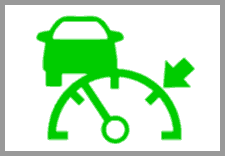 Adaptive Cruise Control
Adaptive Cruise Control
The Ford Explorer adaptive cruise control system uses radar and camera sensors to combine speed sign recognition with adaptive cruise control to adjust the cruise set speed to the speed limit detected by the speed sign recognition system.
The Ford Explorer adaptive cruise control system can be used alongside lane centering and also with the engine automatic stop and go system. The adaptive cruise control symbol illuminates in white when the system is switched on and in green when the system is operating.
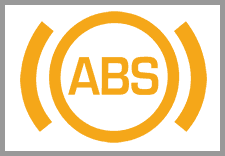 Anti-lock Braking System
Anti-lock Braking System
When your car’s wheels lock, you can’t steer. The Ford Explorer Anti-lock Braking System (ABS) helps to prevent this by releasing the brakes just before they lock. This is done many times per second and can be felt as a pulsing action on the brake pedal.
If the ABS light remains constantly lit, it means the system has malfunctioned. The most frequent reasons for ABS failure is due to a faulty wheel speed sensor. The ABS is a separate system from your brakes and as such, if the ABS light illuminates, your brake will continue to operate.
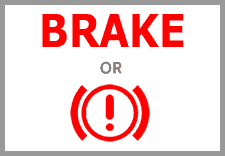 Brake System
Brake System
The Ford Explorer red brake warning light illuminate when the ignition is set to ‘on’ and should turn off shortly after. If the brake warning light fails to illuminate, have the warning light checked so that can warn you of any problems.
The brake warning light illuminate when:
- The parking brake is applied
- The brake fluid reservoir is low on fluid
- There’s a brake fault
If the brake warning light illuminates constantly, check to ensure the parking brake is properly released. If it is, check under the hood for brake fluid levels. If the brake fluid level is between the MIN and the MAX marks on the reservoir, it is acceptable.
Brake fluid levels naturally fall as brake pad wear increases. However, low brake fluid levels may be an indicator of a leak. For the Ford Explorer, the recommended brake fluid is to use DOT 4 Low Viscosity (LV) high performance brake fluid or equivalent meeting WSS-M6C65-A2.
If brake fluid levels are already acceptable, there may be a brake system failure. Have your vehicle looked at immediately.
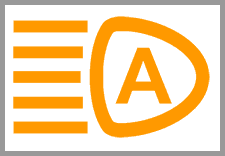 Auto High Beams
Auto High Beams
The Ford Explorer automatic high beams system monitors the road ahead by use of the centrally mounted camera at the top of the windshield. The system automatically switches on high beams when no other traffic is present and switches high beams off when other vehicle’s headlights, tail lights or street lighting is detected. If the system is not working as expected, ensure the view of the camera sensor is clear from dirt.
 Auto Hold
Auto Hold
The Ford Explorer auto hold system is an extension of the parking brake. To help prevent the vehicle from rolling back on a hill, Auto hold automatically applies the brakes when the vehicle comes to a standstill.
You may see see the Auto Hold warning light with a stick though it, meaning that Auto Hold is unavailable. This may be due to Active Park Assist (if fitted), or Stay in Neutral Mode being activated. Auto Hold will only work when the driver’s door is shut and the seat belt fastened. Auto Hold works using wheels speed sensors.
 Auto Start Stop
Auto Start Stop
The Ford Explorer auto start stop is a system that automatically shuts off the engine when the vehicle comes to a standstill using the footbrake and restarts the engine when the brake pedal is released. The system is designed to reduce fuel consumption and pollution.
 Battery Charge
Battery Charge
As with many warning lights, the battery warning light should come on initially with the ignition and go off shortly after the engine has started. If the battery light comes on while you’re driving, it means there’s a problem with the electrical charging system. Common reasons for the battery light coming on are:
- Failing alternator
- Alternator belts loose or broken
- Battery connections
- Wiring issues
- Old / ageing battery
If the battery light comes on while driving, it’s probable that the engine may switch off when battery charge is depleted. Immediately switch off any electrical equipment that’s not essential and make your way immediately to a vehicle repair workshop.
 Blind Spot Monitoring
Blind Spot Monitoring
The blind spot monitoring system is designed to monitor and warn the driver if a vehicle has entered the blind spot zone that occurs to the left and right sides of the vehicle. In the case of the Ford Explorer, the system activates when the vehicle’s speed is 6 mph or greater and a warning light in the applicable side mirror will alert the driver of a vehicle in the blind spot.
The system utilizes two sensors located on each corner of the rear bumper. If the sensor has received an impact, or is covered in dirt or snow, the system may not operate as intended.
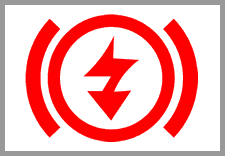 Electric Parking Brake
Electric Parking Brake
Versions of the Ford Explorer that have an electric parking brake require operation via a switch ![]() located in the center console or to the left-side of the steering wheel on the lower part of the instrument panel.
located in the center console or to the left-side of the steering wheel on the lower part of the instrument panel.
If the electric parking brake warning light flashes or fails to illuminate at all, it means there’s a fault with the system. Common reasons for the electric parking brake to fail can be low battery voltage or faulty switch.
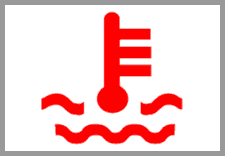 Engine Coolant
Engine Coolant
The engine coolant warning light should come on briefly when the engine is start, then going off shortly after. If it comes on while driving, it means the engine is overheating. This may be due to the engine being overly exerted, or there’s not enough coolant.
If the coolant light comes on while driving, pull off the road when safe and switch off the engine. Check coolant levels. The engine cooling system is under pressure. When loosening the coolant reservoir cap, steam and hot liquid can come out forcefully. To reduce the risk of personal injury, make sure the engine is cool before unscrewing the coolant pressure relief cap. Make sure that the coolant level is between the MIN and MAX marks on the coolant reservoir. If not, add coolant.
Other reasons for the coolant light being on can be water pump fault, a leak, coolant sensor fault. If the light remains lit after adding fluid, do not continue driving as it may result in engine damage. Maintain coolant concentration within 48% to 50%, which equates to a freeze point between -29°F (-34°C) and -35°F (-37°C).
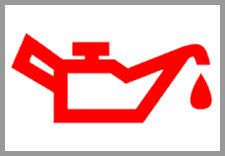 Low Oil Pressure
Low Oil Pressure
The low oil pressure warning light may come on due to the oil pump failing to circulate enough oil, or that there’s not enough oil in the system. If the oil light comes on, stop as soon as safely possible and switch off the engine. Low oil pressure can cause severe engine damage.
Check oil levels and top up if low, but only continue to drive if the oil light goes off. Use a 5W-30 based oil, specification: WSS-M2C946-B1.
 Airbag
Airbag
The Ford Explorer airbag warning light remaining constantly lit or flashing means there’s a system error. There are various reasons why the airbag light comes on, including:
- Airbag system has been manually deactivated
- Airbag crash sensors – there many be a fault due to a minor collision
- Seat belt pre-tensioner fault
- Cables and connectors have been dislodged under the front seats
- Passenger occupancy sensor fault
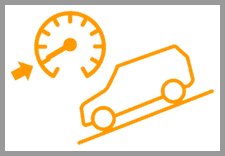 Hill Descent Mode
Hill Descent Mode
The Ford Explorer hill descent system allow the driver to maintain a set speed while descending a hill. The hill descent system will maintain this speed provided that the vehicle is travelling at 20 mph or less. To operate the Ford Explorer’s hill descent system:
- Press the hill descent button in the center console
- To increase the descent speed of your vehicle, press the accelerator
- To reduce the descent speed of your vehicle, press the brake pedal
- Once you have reached your preferred speed, remove your feet from the pedals
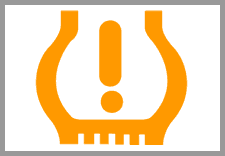 Tire Pressure
Tire Pressure
The Ford Explorer is equipped with a Tire Pressure Monitoring System (TPMS) which alerts the driver via a warning light if one or more tires has become underinflated. Use the tire pressure label located on the edge of driver’s door or the B-Pillar to find the correct pressures for your vehicle. Tire pressures should be adjusted when cold, see cold tyre pressure explained.
After inflating the tires to the correct pressures, the vehicle must be driven for at least two minutes over 20 mph (32 km/h) before the light turns off.
If the tire pressure warning light flashes, it indicates a fault. TPMS faults occur due to:
- A tire, such as the spare being fitted that does not contain a pressure sensor
- A sensor has been damaged during a tire change
- Tire pressure sensor battery has expired
- Tires or wheels that have been fitted and not in accordance with manufacturer’s recommendation
 Powertrain Fault
Powertrain Fault
The wrench symbol is the Ford Explorer powertrain warning light. The powertrain is a very broad level of components and includes everything from the engine, transmission, driveshafts – essentially anything that powers your vehicle forward.
However, if the powertrain warning light comes on, it’s usually related to a fault within the automatic transmission, or in the case of the Ford Explorer, a fault with the 4WD system. In this situation, your vehicle may enter reduced engine power mode (limp mode) as a safety precaution.
Due to many potential reasons behind the powertrain warning light, diagnostic equipment is required to read fault codes. Diagnostic scanners can either be purchased or most vehicle workshops will take a look for you.
 Engine Warning Light
Engine Warning Light
The Ford Explorer service engine soon warning light, often called check engine light comes on and remain on when the on-board diagnostics system has detected a error in the vehicle emission control system. It’s usually safe to continue driving with the engine warning light on, but it’s advised to have the vehicle checked as soon as possible and the fault may worsen.
If the engine warning light flashes, it can be due to an engine misfire which can result in damage to the catalytic converter. In this instance, reduce speed and engine load. If the engine light still flashes, have your vehicle looked at immediately.
Although it’s difficult to determine the reason for the engine warning light without diagnostic equipment, a faulty oxygen sensor is the most common reason. Other common reasons for the engine light can include spark plugs / glow plugs, mass airflow sensor, catalytic converters problems, loose gas cap.
It’s only possible to locate the fault by using diagnostic scan equipment. Each time the engine warning light comes on, a fault code is stored. Diagnostic equipment is used to read the fault codes and locate the fault.
 Stability Control
Stability Control
The Ford Explorer stability control system is designed to reduce both understeer, oversteer and loss of traction. If the stability light flashes, it means the system is actively attempting to stabilize the vehicle. If the light remains constantly lit, it means there’s a fault. The usual cause for the stability control system to malfunction is due to one of the four wheel speed sensors failing. For further information, see What ESC is in Cars.
 Stop Safely Now
Stop Safely Now
The Ford Explorer stop safely now warning light is a red triangle containing an exclamation point. It illuminates when a critical fault occurs that will either cause the vehicle to shut down or to enter reduced power mode / limited operating mode. It may be required for you to arrange vehicle recovery.
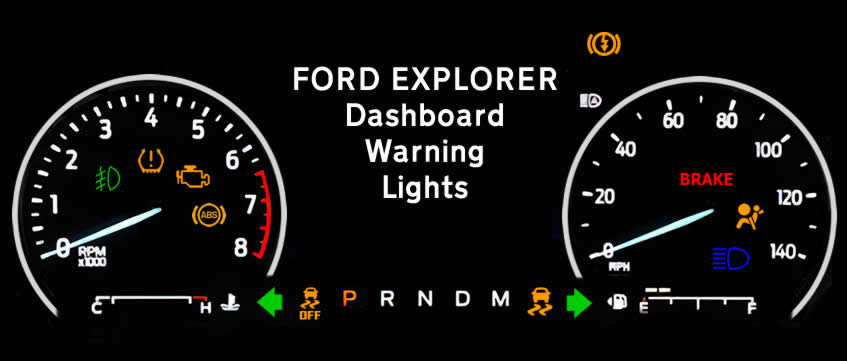
2018 Ford Explorer
What does a red exclamation point with a circle around it mean?
This is not online or in the owners manual.
Hi Mark,
Are you referring to the brake warning light at the top of this page? It can come on for a few reasons; first is to check the parking brake handbrake is properly released, if it is, then check the brake fluid reservoir to ensure fluids are up to recommended levels. Check brake pads and if the light is still on, then you have a brake fault.
Trip appears on the dashboard, then goes off with a click, then the dashboard lights go off and comes back.
What does that mean?